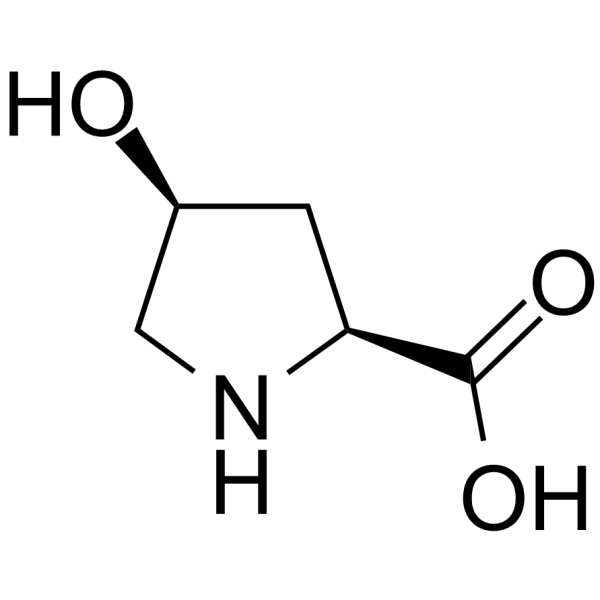
cis-4-Hydroxy-L-proline
CAS No. 618-27-9
cis-4-Hydroxy-L-proline ( —— )
产品货号. M28133 CAS No. 618-27-9
cis-4-Hydroxy-L-proline 是胶原蛋白合成和细胞外沉积的抑制剂。 cis-4-Hydroxy-L-proline 可以通过阻止三螺旋胶原蛋白在细胞层上的沉积来抑制成纤维细胞的生长。
纯度: >98% (HPLC)
 COA
COA
 Datasheet
Datasheet
 HNMR
HNMR
 HPLC
HPLC
 MSDS
MSDS
 Handing Instructions
Handing Instructions
| 规格 | 价格/人民币 | 库存 | 数量 |
| 100MG | ¥316 | 有现货 |


|
| 500MG | ¥737 | 有现货 |


|
| 1G | 获取报价 | 有现货 |


|
生物学信息
-
产品名称cis-4-Hydroxy-L-proline
-
注意事项本公司产品仅用于科研实验,不得用于人体或动物的临床与诊断
-
产品简述cis-4-Hydroxy-L-proline 是胶原蛋白合成和细胞外沉积的抑制剂。 cis-4-Hydroxy-L-proline 可以通过阻止三螺旋胶原蛋白在细胞层上的沉积来抑制成纤维细胞的生长。
-
产品描述cis-4-Hydroxy-L-proline is an inhibitor of the synthesis and extracellular deposition of collagen. cis-4-Hydroxy-L-proline could inhibit fibroblast growth by preventing the deposition of triple-helical collagen on the cell layer.(In Vivo):cis-4-Hydroxy-L-proline depressed the growth of primary N-nitrosomethylurea-induced rat mammary tumors.
-
体外实验——
-
体内实验——
-
同义词——
-
通路Proteasome/Ubiquitin
-
靶点Endogenous Metabolite
-
受体Telomerase
-
研究领域——
-
适应症——
化学信息
-
CAS Number618-27-9
-
分子量131.131
-
分子式C5H9NO3
-
纯度>98% (HPLC)
-
溶解度In Vitro:?H2O : 100 mg/mL (762.60 mM)
-
SMILESO[C@@H]1CN[C@@H](C1)C(O)=O
-
化学全称——
运输与储存
-
储存条件(-20℃)
-
运输条件With Ice Pack
-
稳定性≥ 2 years
参考文献
1.Ameri Z, et al. Telomerase inhibitor MST-312 induces apoptosis of multiple myeloma cells and down-regulation of anti-apoptotic, proliferative and inflammatory genes. Life Sci. 2019;228:66-71.
产品手册




关联产品
-
Alanylphenylalanine
Alanylphenylalanine 是一种内源性代谢产物。
-
Docosapentaenoic aci...
二十二碳五烯酸 22n-3 存在于所有动物的细胞膜中,是磷脂的组成部分。
-
1-Methyl-6-oxo-16-di...
1-甲基-6-氧代-1,6-二氢吡啶-3-甲酰胺是烟酰胺腺嘌呤二核苷酸(NAD)的最终降解产物之一。



 021-51111890
021-51111890 购物车(0)
购物车(0)
 sales@molnova.cn
sales@molnova.cn







